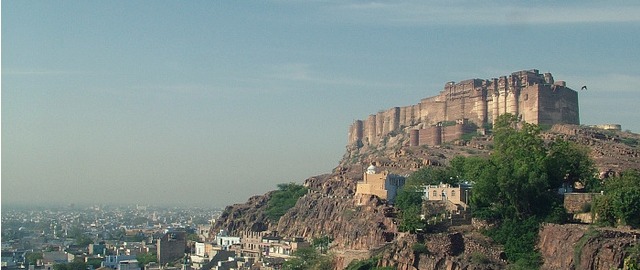
Forts of Rajasthan – Majestic Splendor
It’s for a reason that Rajasthan is one of the most visited states in India. Numerous havelis forts and palaces reflect the heritage of the Rajput kings who ruled over the territory and offer visitors a glimpse into the past. Forts, which were built primarily for defending the territory, are the most majestic structures, enclosing within their walls living and administrative units, including beautiful palaces that put on display the wealth and opulent lifestyle of the kings. The best forts in Rajasthan not only showcase a slice of ancient life, but also have legends of war, valor, romance, sacrifice and beauty that are as awe inspiring as their imposing architecture.
Mehrangarh Fort, Jodhpur
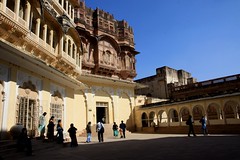 The burnished red sandstone structure of Mehrangarh fort takes center stage in Jodhpur, looking down at the city from atop a rocky hill that’s 400 feet high. The foundation for the fort was laid by Jodha Rao in 1459, the fifteenth ruler of the Rathore dynasty of Jodhpur, when he decided to move the capital from Mandore. The walls, in addition to being 118 feet high, are 69 feet wide with seven gates barricading entry to the main complex. The first of these gates, Jai Pol (meaning ‘Victory gate’), was built by Maharaja Man Singh in 1806 as a celebration of his victory in the war against Bikaner and Jaipur. Loha Pol, the final gate, has on the wall beside it the hand prints of the maharanis, who committed sati (immolation on the funeral pyre of Maharaja Man Singh).
The burnished red sandstone structure of Mehrangarh fort takes center stage in Jodhpur, looking down at the city from atop a rocky hill that’s 400 feet high. The foundation for the fort was laid by Jodha Rao in 1459, the fifteenth ruler of the Rathore dynasty of Jodhpur, when he decided to move the capital from Mandore. The walls, in addition to being 118 feet high, are 69 feet wide with seven gates barricading entry to the main complex. The first of these gates, Jai Pol (meaning ‘Victory gate’), was built by Maharaja Man Singh in 1806 as a celebration of his victory in the war against Bikaner and Jaipur. Loha Pol, the final gate, has on the wall beside it the hand prints of the maharanis, who committed sati (immolation on the funeral pyre of Maharaja Man Singh).
Mehrangarh fort also has beautiful palaces, which are ornately decorated, including Moti Mahal (Pearl Palace), Sheesh Mahal (Mirror Palace) and Phool Mahal (Flower Palace). It’s one of the best preserved forts in India and has a museum within that displays treasures, armory, paintings and other artifacts.
Chittorgarh Fort
 Built between the 5th and 8th century by Mauryan ruler, Chitrangad Mori, from whom it gets its name, Chittorgarh is the largest fort in India, spread over 691 acres (280 ha) and stands at an imposing height of 590 feet. However, it’s the stories of valor and tragedy of the Mewar rulers and their families that makes this fort famous. It was attacked thrice between the 15th and 16th century – the first time by Alauddin Khilji (who was besotted with Rani Padmini, the beautiful queen of Maharaja Ratan Singh), following which the queen and the royal ladies performed jauhar (self-immolation on a pyre) rather than having to face the
Built between the 5th and 8th century by Mauryan ruler, Chitrangad Mori, from whom it gets its name, Chittorgarh is the largest fort in India, spread over 691 acres (280 ha) and stands at an imposing height of 590 feet. However, it’s the stories of valor and tragedy of the Mewar rulers and their families that makes this fort famous. It was attacked thrice between the 15th and 16th century – the first time by Alauddin Khilji (who was besotted with Rani Padmini, the beautiful queen of Maharaja Ratan Singh), following which the queen and the royal ladies performed jauhar (self-immolation on a pyre) rather than having to face the 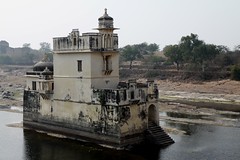 indignity of being captured. The second attack was by Sultan Bahadur Shah in 1535, and the final attack came from Emperor Akbar in 1567, after which fort was never resettled.
indignity of being captured. The second attack was by Sultan Bahadur Shah in 1535, and the final attack came from Emperor Akbar in 1567, after which fort was never resettled.
The complex has several gates, palaces and temples. Among the gates, Padam Pol, Bhairon Pol, Hanuman Pol and Ram Pol are the most noteworthy. Other interesting buildings and monuments include Vijay Stambh (a nine-storeyed victory tower built by Maharaja Kumbha after he defeated the Muslim rulers in 1440), Padmini Palace (where Alauddin Khilji was shown the reflection of Rani Padmini) and the Kumbha Palace (the site where the royal ladies performed jauhar). Fateh Prakash Palace houses a museum that displays armor, art and artifacts of the early Rajputs.
Jaisalmer Fort
 Built from yellow sandstone that almost acts as a camouflage in the surrounding desert terrain, the Jaisalmer fort is known as ‘Sonar Qila’ or Golden Fort due to the golden yellow vision it presents at sunset – a breathtaking spectacle. Situated at a height of 250 feet on Trikuta Hill, this fort too has witnessed many battles and sacrifices. With three walls protecting its complex, Jaisalmer fort was considered impenetrable until Alauddin Khilji seized it in the 13th century. The siege led to the royal ladies committing jauhar.
Built from yellow sandstone that almost acts as a camouflage in the surrounding desert terrain, the Jaisalmer fort is known as ‘Sonar Qila’ or Golden Fort due to the golden yellow vision it presents at sunset – a breathtaking spectacle. Situated at a height of 250 feet on Trikuta Hill, this fort too has witnessed many battles and sacrifices. With three walls protecting its complex, Jaisalmer fort was considered impenetrable until Alauddin Khilji seized it in the 13th century. The siege led to the royal ladies committing jauhar.
Once a fortified city, which contained the entire population of Jaisalmer, the fort has within its complex gates, havelis, palaces and temples. The four major gates are Akshaya Pole, Ganesh Pole, Hawa Pole and Suraj Pole. The main palace – Raj Mahal – is now a museum. Besides this, the fort has Jain temples and beautiful havelis that belonged to wealthy merchants of the city.
Amber Fort, Jaipur
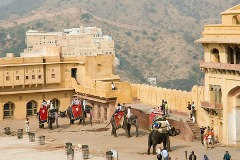 Located on the outskirts of Jaipur, Amber Fort or Amer Fort as it is also called is a popular sight in Jaipur. Perched on top of a hill, the fort is as much known for its blend of Hindu and Rajput architectural styles as for the elephant ride to the top, which gives visitors a unique experience of royal life. It was built by Raja Man Singh I in the 16th century, with subsequent additions being made by his successors.
Located on the outskirts of Jaipur, Amber Fort or Amer Fort as it is also called is a popular sight in Jaipur. Perched on top of a hill, the fort is as much known for its blend of Hindu and Rajput architectural styles as for the elephant ride to the top, which gives visitors a unique experience of royal life. It was built by Raja Man Singh I in the 16th century, with subsequent additions being made by his successors.
With a view of the Maota Lake in front, the fort is an outstanding example of the opulence as well as the artistry and architectural expertise of the Rajputs. Built with a combination of red sandstone and marble, the fort complex has many interesting buildings, including a hall for public audience (Diwan-e-aam) and a hall of private audience (Diwan-e-Khas). Other sights include Sheesh Mahal (Mirror Palace) and Sukh Niwas (Palace of Pleasure).
Junagarh Fort, Bikaner
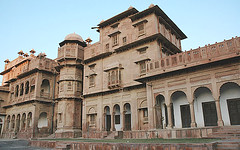 Despite being on the plains unlike several other major forts in Rajasthan, Junagarh has the reputation of being one of the most invincible as throughout its history, it was under siege only for a day, when Kamran Mirza (Son of Emperor Babur) occupied it in 1534. Soon afterwards, the Rathores defeated the Mughals, and Kamran fled to Lahore.
Despite being on the plains unlike several other major forts in Rajasthan, Junagarh has the reputation of being one of the most invincible as throughout its history, it was under siege only for a day, when Kamran Mirza (Son of Emperor Babur) occupied it in 1534. Soon afterwards, the Rathores defeated the Mughals, and Kamran fled to Lahore.
The fort is spread over 5.28 hectares and was initially built by Raja Rai Singh in 1588. Subsequent additions and modifications by sixteen successive generations of Bikaner rulers has resulted in a blend of architectural styles from early Rajput design to Mughal, Gujarati and western influences. The best features include the two entrances (Suraj Pole and Karan Pole), Chand Mahal (Moon Palace), Phool Mahal (Flower Palace decorated with mirror and glass), Anup Mahal (with red and gold lacquer work on its walls) and Badal Mahal (Cloud Palace with exquisite frescoes).
Taragarh Fort, Bundi
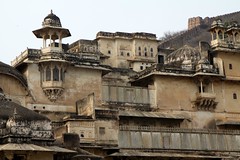 Taragarh, which translates to ‘Star Fort’, is one of the most picturesque ancient forts of Rajasthan. Set on a steep hillside, in Bundi near Kota, it was built in 1354. While a large part of the fort complex has fallen to ruin, it makes for an off-the-beaten-track experience spent exploring its structures and buildings, including the three gateways, the Rani Mahal (Palace for the queens) and the crisscrossing network of reservoirs, which were cut from stone and used for storing water to be supplied to residents during crises.
Taragarh, which translates to ‘Star Fort’, is one of the most picturesque ancient forts of Rajasthan. Set on a steep hillside, in Bundi near Kota, it was built in 1354. While a large part of the fort complex has fallen to ruin, it makes for an off-the-beaten-track experience spent exploring its structures and buildings, including the three gateways, the Rani Mahal (Palace for the queens) and the crisscrossing network of reservoirs, which were cut from stone and used for storing water to be supplied to residents during crises.
Besides these six majestic defense structures, there are hundreds of other forts and palaces in Rajasthan that bring to life the grandeur of the Rajputs.


I have been to Jaipur, Jaisalmer and Jodhpur and loved all the forts specially Mehrangarh fort but now i want to visit Chittorgardh and bundi too thanks to your post 🙂